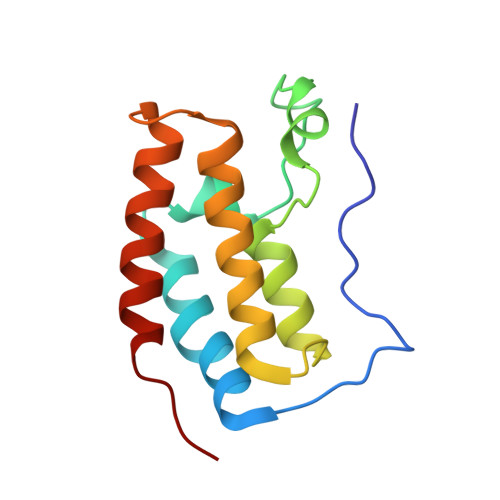Discovery of Benzo[cd]indol-2(1H)-ones and Pyrrolo[4,3,2-de]quinolin-2(1H)-ones as Bromodomain and Extra-Terminal Domain (BET) Inhibitors with Selectivity for the First Bromodomain with Potential High Efficiency against Acute Gouty Arthritis.
Jiang, F., Hu, Q., Zhang, Z., Li, H., Li, H., Zhang, D., Li, H., Ma, Y., Xu, J., Chen, H., Cui, Y., Zhi, Y., Zhang, Y., Xu, J., Zhu, J., Lu, T., Chen, Y.(2019) J Med Chem 62: 11080-11107
- PubMed: 31789032
- DOI: https://doi.org/10.1021/acs.jmedchem.9b01010
- Primary Citation of Related Structures:
6JJ3, 6JJB - PubMed Abstract:
The bromodomain and extra-terminal domain (BET) family of proteins are readers which specifically recognize histone-acetylated lysine residues. Each BET bromodomain protein contains two highly homologous domains: the first bromodomain (BD1) and the second bromodomain (BD2). Pan-BET bromodomain inhibition is a potential therapy for various cancers and immune-inflammatory diseases, but only few reported inhibitors show selectivity within the BET family. Herein, we identified a series of benzo[ cd ]indol-2(1 H )-ones and pyrrolo[4,3,2- de ]quinolin-2(1 H )-ones with good selectivity for BET BD1. Through structure-based optimization, highly active and selective compounds are ultimately obtained. The representative compounds are the first reported inhibitors with selectivity more than 100-fold for BRD4(1) over BRD4(2). Among them, we further show that 68 (LT052) mediates BRD4/NF-κB/NLRP3 signaling inflammatory pathways with comparable protein expression and significantly improves symptoms of gout arthritis in a rat model. Therefore, selective pharmacological modulation of individual bromodomains could represent a strategy for the treatment of acute gouty arthritis.
Organizational Affiliation:
School of Sciences , China Pharmaceutical University , 639 Longmian Avenue , Nanjing 211198 , P. R. China.



















